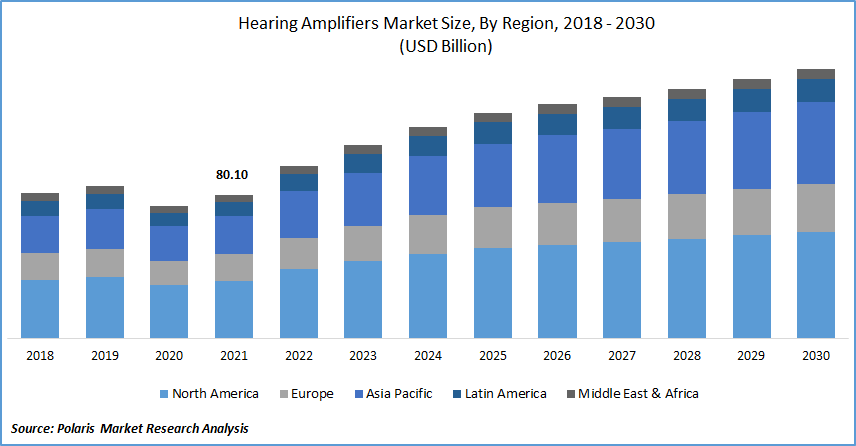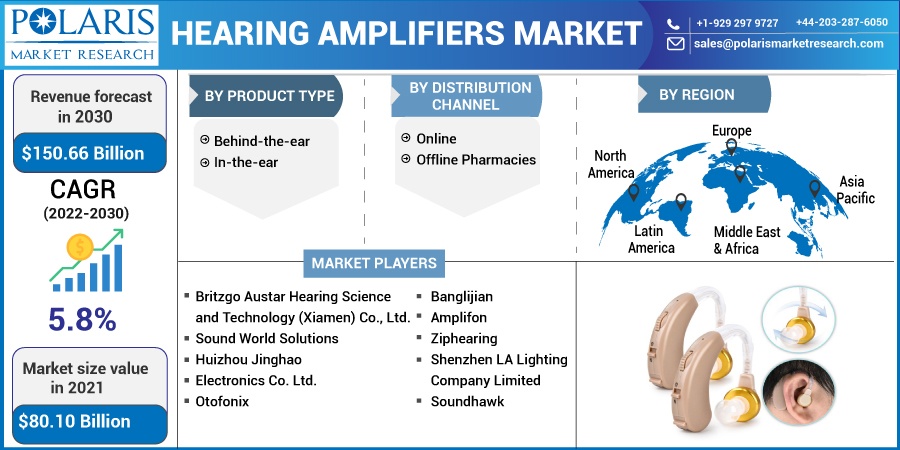
Hearing Amplifiers Market Share, Size, Trends, Industry Analysis Report, By Product Type (Behind-the-ear, In-the-ear); By Distribution Channel (Online, Offline Pharmacies); By Region; Segment Forecast, 2022 - 2030
- Published Date:Aug-2022
- Pages: 114
- Format: PDF
- Report ID: PM2529
- Base Year: 2021
- Historical Data: 2018 - 2020
Report Outlook
The global hearing amplifiers market was valued at USD 80.10 billion in 2021 and is expected to grow at a CAGR of 5.8% during the forecast period. Increased frequency of moderate deafness in the young and adult population is one of the major market-driving factors. Increasing R&D initiatives performed by industry players to create cutting-edge products will promote industry expansion throughout the forecast period.
 Know more about this report: Request for sample pages
Know more about this report: Request for sample pages
One major factor is thought to be the rise in demand for personal sound amplification products (PSAP) among the elderly population. Half of the people over the age of 75 have listening loss, which presents a market potential. It is estimated that one in three Americans aged 65 to 74 is deaf to some extent.
Hearing loss is a critical disease that can lead to dementia, difficulties walking and falls. Due to the condition's impact on the inner ear, which regulates body balance, there is an increased chance of falls and social isolation because of listening loss. These factors may further contribute to depression and a reduction in general mental health.
There are many adults who suffer from listening loss; in the United States, 37.5 million adults over the age of 18 have some form of hearing loss, which accounts for 15% of all adults. Another significant market driver is projected to be the rising prevalence among the younger generation. Growth is predicted to be aided by the leading companies' growing R&D initiatives.
 Know more about this report: Request for sample pages
Know more about this report: Request for sample pages
Industry Dynamics
Growth Drivers
The main factors propelling market expansion over the projection period include expanding elderly population susceptible to hearing loss, favorable regulatory circumstances, and the rising prevalence of listening impairment patients. Additionally, the existence of organizations that guarantee adequate treatment for those with listening impairments, technological developments, and continual product innovations are other factors that will fuel the expansion of the sector.
The rising prevalence of these disorders over the past few years has played a significant role in the hearing amplifiers market growth, and the trend is expected to continue throughout the forecast period. The system through which external sound is transmitted to inner parts is typically faulty, or there are issues with the hearing organ or hearing nerve. Congenital listening loss, which is acquired at birth, or acquired listening loss, which can develop at any age, are two possible causes of listening loss. According to data from Johns Hopkins researchers, by 2060, there will be twice as many people living with listening loss.
For instance, the World Health Organization (WHO) reported in April 2021 those 700 million individuals will require rehabilitation by 2050 and that nearly 2.5 billion people currently have some degree of listening loss.
Report Segmentation
The market is primarily segmented based on product type, distribution channel, and region.
|
By Product type |
By Distribution channel |
By Region |
|
|
|
Know more about this report: Request for sample pages
Behind-The-Ear Segment is Expected to Witness Fastest Growth
The behind-the-ear segment dominated the market in terms of product type. The rising demand for this product category over the study period is attributable to elements like high efficiency, improved connection, and longer battery life. The behind-the-ear amplifiers' huge size allows for the installation of other features like Bluetooth and directional microphones, which will help the market grow.
A behind-the-ear amplifier is a small electronic device that enhances a person's ability to hear and facilitates better communication. The use of a microphone, amplifier, and speaker enhances the sound and improves speech understanding for those who have listening loss.
Almost all types of listening loss can be managed by these audio amplifiers, which are typically appropriate for all age groups. Because they offer more amplification, behind-the-ear amplifiers are recommended over most in-the-ear amplifiers. These amplifiers can accommodate big audio amplifier battery sizes, extending their battery life.
Due to the growing popularity of this type of product due to its attractive designs that make the device easy to use, the in-the-ear sector is predicted to grow at the fastest rate during the forecast period. Some of the features that make it easier to adjust the sound to the surrounding are Bluetooth and directional microphones. However, factors like the risk of infection are expected to restrain expansion.
Offline Segment Expected to Witness Fastest Growth
In 2021, the offline segment led the hearing amplifiers market and held most of the revenue. Patients prefer to purchase amplifiers from retail stores is one element that is considered a driving factor of the segment's growth. The preference of major players to launch their items through brick-and-mortar retailers is also attributed to promoting industry expansion throughout the expected period.
For patients with listening loss brought on by other medical conditions, hospital pharmacists offer over-the-counter audio amplifiers. Furthermore, because many of them are aware of modern alternative pharmacies, such as online pharmacies, the geriatric population prefers to purchase audio amplifiers through hospital pharmacies. Thus, during the next year, segmental growth will be further aided by consumers' rising demand at offline pharmacies.
Due to the huge number of young people with deafness who prefer to purchase amplifiers online, the online sales category is predicted to increase at the fastest rate throughout the forecast period. By actively entering the amplifiers market segment and listing their items on e-commerce platforms, the leading players are expected to contribute to the market's growth throughout the course of the forecast year.
The Demand in Europe is Expected to Witness Significant Growth
The hearing amplifiers market has been dominated by Europe, which also generated the most revenue in 2021. The market is attributed to being driven by the rapid acceptance of PSAPs due to the rise in the prevalence of deafness and their use as less expensive alternatives to such aids. According to the World Health Organization, 196 billion people in Europe are expected to have some form of hearing disease in 2021, and 6.2 % of those individuals, or 57.3 billion patients, would have moderate or severe listening loss.
North America is expected to be the fastest-growing in the global hearing amplifiers market over the forecast period. The adoption rate of audio amplifiers will be driven by the increased prevalence of such disorders in the area. Strong state support and activities by numerous regional organizations are further factors in the expansion of the audio amplifiers industry. Moreover, the industry growth for audio amplifiers will be boosted in the next years by rapid technology advancements and a good reimbursement environment.
During the forecast period, Asia Pacific is expected to witness the fastest growth. The development of cutting-edge products by the major players and factors like the rising prevalence of such diseases are thought to be driving the market growth. According to a hearing-it article, 666 million individuals in the South-East Asia region will have listening loss by the year 2050, rising from an estimated 401 million in 2021. It is anticipated that such a factor will significantly increase demand for these amplifiers in the Asia Pacific.
Competitive Insight
Some of the major players operating in the global market include Britzgo Austar Hearing Science and Technology (Xiamen) Co., Ltd., Sound World Solutions, Huizhou Jinghao Electronics Co. Ltd., Otofonix, Banglijian, Amplifon, Ziphearing, Shenzhen LA Lighting Company Limited, Soundhawk, FocusEar, Resound, MDHearingAid, Beurer, Etymotic Research, IntriCon Corporation and others.
Recent Developments
- For instance, in 2021, Amplifon completed the acquisition of the PJC Hearing, the hearing care of the PJC Investments, which dominates major markets across the globe.
- In November 2021, InnerScope partnered with the Atlazo, with the aid of Atlazo's unique Artificial Intelligence platform. These features include voice commands, and the seamless networking.
Hearing Amplifiers Market Report Scope
|
Report Attributes |
Details |
|
Market size value in 2021 |
USD 80.10 billion |
|
Revenue forecast in 2030 |
USD 150.66 billion |
|
CAGR |
5.8% from 2022 - 2030 |
|
Base year |
2021 |
|
Historical data |
2018 - 2020 |
|
Forecast period |
2022 - 2030 |
|
Quantitative units |
Revenue in USD billion and CAGR from 2022 to 2030 |
|
Segments covered |
By Product Type, By Distribution Channel, By Region |
|
Regional scope |
North America, Europe, Asia Pacific, Latin America, Middle East & Africa |
|
Key companies |
Britzgo Austar Hearing Science and Technology (Xiamen) Co., Ltd., Sound World Solutions, Huizhou Jinghao Electronics Co. Ltd., Otofonix, Banglijian, Amplifon, Ziphearing, Shenzhen LA Lighting Company Limited, Soundhawk and others. |
